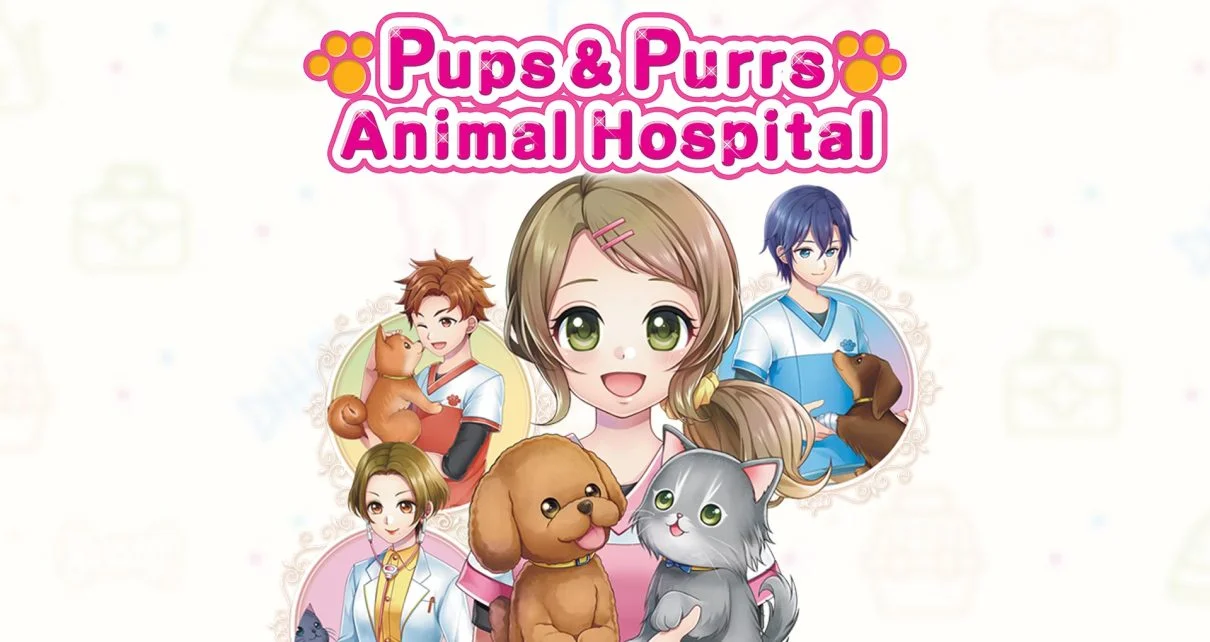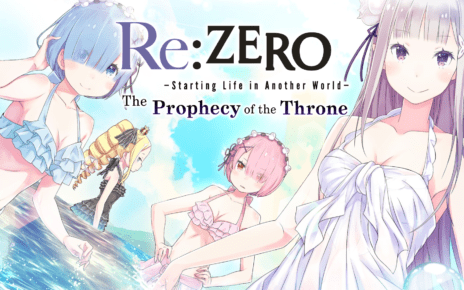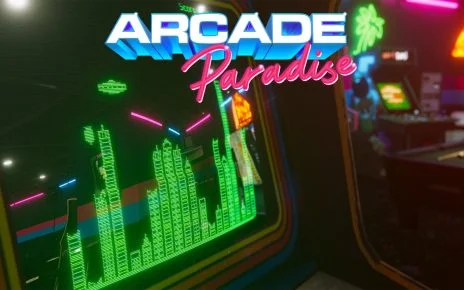Published by Numskull Games and Aksys Games in November 2021, Pups & Purrs: Animal Hospital — the English version of Wan Nyan Doubutsu Byouin: Pet o Tasukeru Daiji-na Oshigoto released in July 2020 in Japan — is a vet simulation game developed by Nippon Columbia for the Nintendo Switch. While Pups & Purrs: Animal Hospital’s conspicuous kawaii aesthetics and even cuter pets grabbed my attention immediately, beyond its delightful fluff unexpectedly lies actual substance.
The Newest Veterinarian in Town
In Pups & Purrs: Animal Hospital, you play as a female veterinarian who has recently completed her veterinary education and is starting work at the local animal hospital. The protagonist’s journey from an aspiring to a world-class veterinarian unfolds over seven short but generally eventful slice-of-life chapters under Story Mode. Once the final chapter closes, the credits roll will be shown but the game allows you to continue playing the same playthrough indefinitely without having to start a new game.
Like most work sims, there is a recurring work schedule, though the calendar in Pups & Purrs: Animal Hospital is pretty much streamlined. Each month is made up of six days, and they are split into two workdays followed by one rest day and then two workdays again before another day off. Every workday is divided into morning and afternoon work hours, with lunchtime sandwiched in between. Rest days have similar morning and afternoon hours too, and depending on the activity chosen, either half a day or an entire day will pass by.
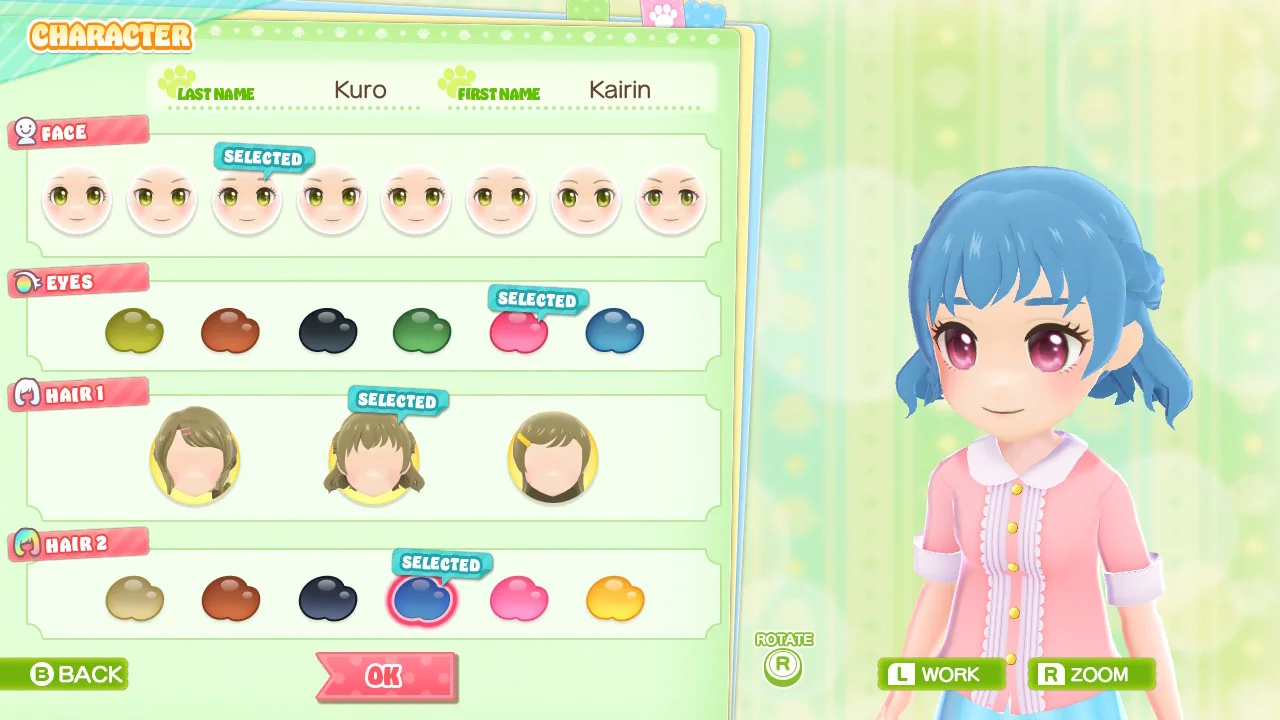
Despite the inclusion of rest days and the game’s constant emphasis on the importance of having a good work-life balance, work takes up the main bulk of the gameplay time anyway. Apart from the first two introductory workdays where the workload is very minimal, there is a usual workload of three to six patients to take care of per day at the animal hospital. Patients are randomized and so are their health issues. However, it is possible to consecutively get patients with the exact same issues and treatment plans within the same workday, especially towards and after the end-game. Whenever that occurs and I’ve had to repeatedly play the same treatment mini-games back-to-back, I tend to find that particular workday incredibly dry and grindy. Luckily, the cute pets’ cheerful faces at the end of each successful treatment are enough to pull me through those dull, repetitive moments.
For each mini-game, you are awarded up to three work stamps based on your performance. The only way to attain zero work stamps from a session is to do nothing at all during the entire six minutes allocated for a patient’s checkup. Work stamps are your stepping stones to reaching the next ranks of your profession, which in turn opens you to higher base salaries, more work outfits, and eventually freedom in choosing your preferred examination room for the workday. I’m impressed by these progression benefits that bring surprisingly new and often better changes to the existing game elements. Not only do they serve as nice rewards to look forward to after putting in the effort to level up, but they also portray the player character’s gradual increase in seniority at the animal hospital. In addition, Pups & Purrs: Animal Hospital celebrates each level up with an upbeat animation clip that has similar vibes as a mahou shoujo (magical girl) transformation sequence. The game sure has a knack for making job promotions feel exciting and special even if the increased salaries and additional cosmetic items may become less relevant the further you progress.

Let’s Help Our Furry Friends
Starting your first day at work in Pups & Purrs: Animal Hospital feels much like what usually occurs in real life: you will meet your colleagues, be shown around the workplace, and get acquainted with their usual work routine. As part of the game’s tutorial, you will also get your first hands-on session treating a patient. At times, information is provided through character dialogues, some of which you can request a repeat of as many times as you like. Most of the time, however, information is shown via pop-up text boxes that appear only once. There is neither a backlog nor a fixed tutorial menu you can access any time should you accidentally skip past a text box or forget about certain things you had read. Nonetheless, due to the gameplay’s repetitive nature and how few activities you can engage in during and outside of work, the vet sim is on the whole relatively easy to get familiarised with even without detailed instructions. Moreover, the mini-games have their own on-screen controls guides and helpful prompts timed to the player’s input, such as prompting players what to do next if it detects a lack of advancement after some time.
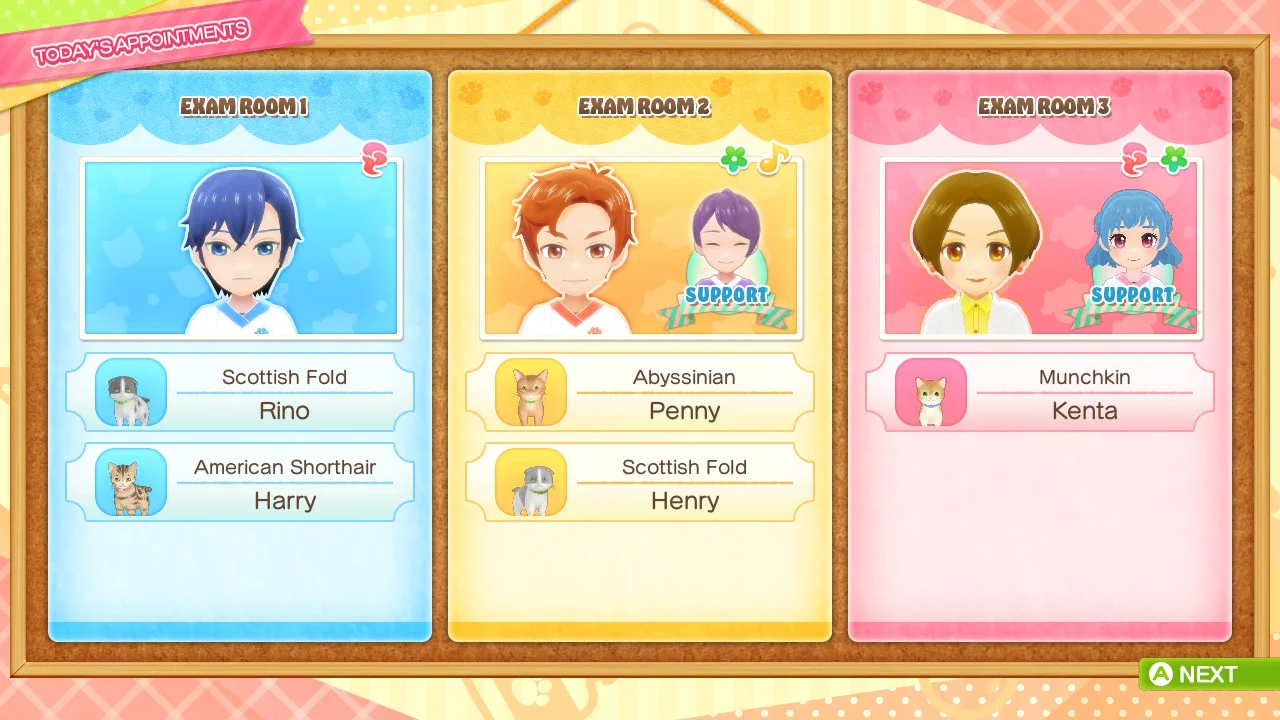
There are three examination rooms at the animal hospital and you will be assigned to Exam Room 3 at the beginning. As you level up, you will have the chance to work in Exam Rooms 2 and 1 as well. Based on the initial narrative, the examination rooms are differentiated by the type of patients, and those with more serious ailments who require more complex diagnostic or treatment tools are sent to the lower-numbered rooms. Although there are noticeable changes in the tools to use and mini-games to play, the differences present among the examination rooms diminish over time. In the end, tools that are supposedly available only in Exam Rooms 1 and 2 can be used in Exam Room 3 as well, and patients who should have gone to a particular room are sent to the others too. The eventual homogeneity of the examination rooms’ patients is quite disappointing as it prevents me from choosing an examination room for its specific set of mini-games. To make matters worse, the randomizer is not great; from the final chapter onwards, there is frequently no significant variation in the mini-games to play in the different examination rooms.
Your workday normally begins with a short free period followed by a morning meeting where everyone will be briefed on their work schedule. This typically involves knowing which colleague is assigned to which examination room, the number of patients waiting for their morning appointments in each room, and your character stats (Motivated, Relaxed, Happy) that will be boosted by working in a particular room. Such information becomes particularly useful after you have leveled up enough to be given the freedom to choose your examination room, allowing you to strategize your workday according to which colleague’s friendship you wish to strengthen or which of your character stats to increase. It is also possible to gauge how much time the morning checkups are going to take, which I found helpful in estimating whether I’d have enough time to plow through the morning appointments in one sitting before the next manual save point rolls by. There are only a few moments when you are allowed to save your game progress manually, and they usually occur before the morning checkups start, during lunchtime, and before sleep.
Once the morning meeting ends, you can approach your examination room to proceed with the checkups, i.e. a series of mini-games, until all the patients scheduled for that session are seen. Right before each patient’s checkup begins, the game will prompt you to choose between Button and Motion Controls. While this offers flexibility and ease for players to change their game controls in between patients, the relentless prompting can be annoying when one has settled on their preferred game controls. After trying Pups & Purrs: Animal Hospital with both controls options, I find Motion Controls, which uses a combination of the console buttons and gyroscope, easier to use. It is also oddly satisfying to shake the console about to replenish an empty bottle of disinfectant with a pleasant rattling sound effect. For Button Controls, I tend to have trouble controlling my cursor movements with the L stick in a few mini-games where precise cursor placement is required. But not many of the mini-games actually rely on the gyroscope, so several mini-games make use of the same controls scheme regardless of the chosen game controls. Furthermore, the mini-game where players look inside a patient’s digestive tract to pick out foreign objects could have used the gyroscope for the camera movement but disappointingly did not. All in all, there are no discernible design differences in the mini-games played with either game controls, except for the mini-game where players stitch up wounds, which has visibly wider interactable areas when Motion Controls is used.

Over the entire course of your vet career in Pups & Purrs: Animal Hospital, you will come across a total of 21 mini-games. The very first mini-game for every patient is always the checkup, where you examine the patient with one or more diagnostic tools such as a magnifying glass, stethoscope, portable X-ray machine, dental mirror, and so on to pinpoint the health issues they have. Then, based on the patient’s ailments, the game will auto-assign treatment plans for them, and your job is to go through each treatment step-by-step to make them healthy and happy again.
Notwithstanding the poor randomizer that sometimes makes it seem like there exist only a handful of mini-games, the variety of mini-games is overall nice. Some of them basically share the same graphics but there was an effort made in making them play like separate mini-games. For example, the mini-games where you pet the patient to calm them down, bathe them, and give them a massage all involve a side-view of the patient as you move two on-screen hands with the L and R sticks. However, the rules for these three mini-games are different; the first one requires you to pet the patient in any direction slowly, the second expects faster movement speed, and the third needs you to follow specific movement directions indicated on the screen. Another pair of mini-games that look similar involve a suction unit and an inhaler respectively, though the former is played by pressing the A button whenever the moving indicator line lines up with the randomly positioned cylinder and the latter is played by tilting the R stick upwards to keep the indicator line afloat within the boundaries of the moving cylinder. The only highly similar mini-games are those where you get rid of fleas and ticks on the patient, though some may find aiming the cursor on the jumping fleas more challenging than on the crawling ticks.
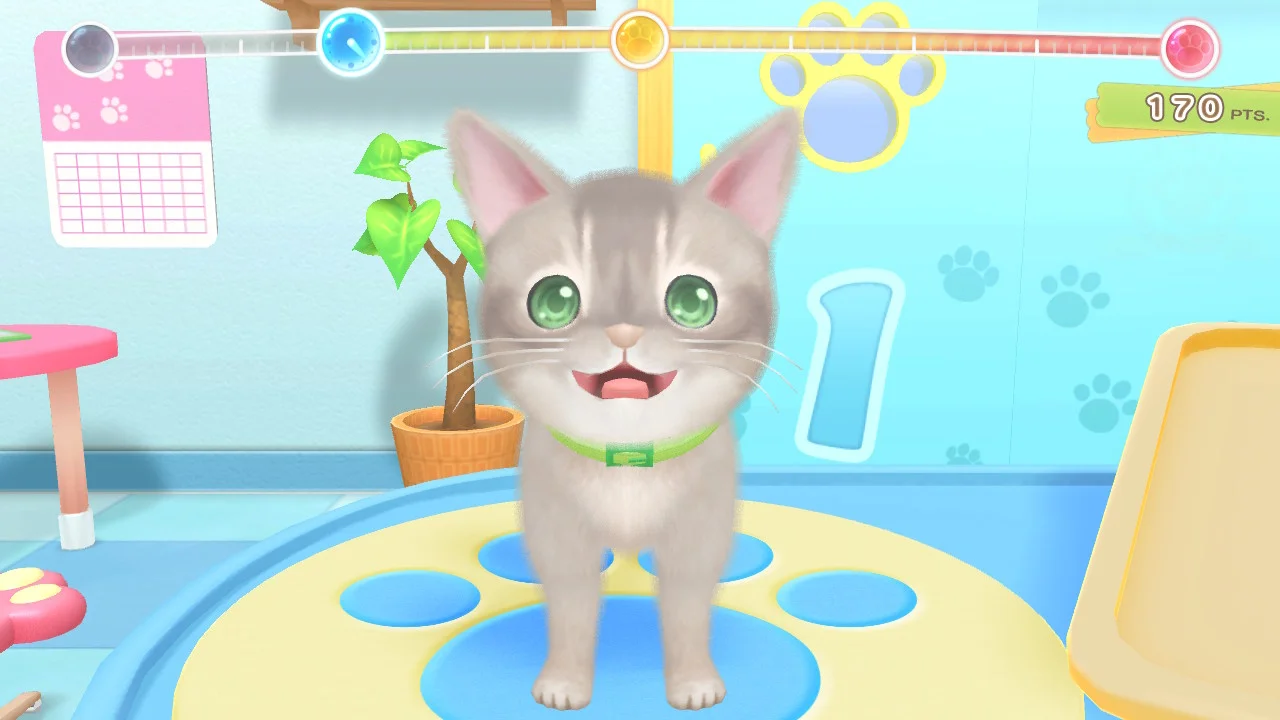
Besides changing the game controls and rules, different mini-games have different background music (BGM) as well. There are around five or six music tracks in total, most of which are upbeat and remind me of a goofy carnival but otherwise do not leave much of an impression.
Of all the mini-games, the only one I disliked playing is wrapping the bandage where I had to rotate the R stick at varying speeds, which tends to tire out my thumb. Otherwise, I appreciate being able to pet the adorable animals and enjoy the massage mini-game’s lively rhythmic tempo that increases as the combo of perfect input increases. I also love seeing the animals lying down relaxed after calming them down, and their little eyes sparkling brightly after I put in eye drops or fed them medicine. Truly, what the mini-games did best is their ability to instill an immense sense of satisfaction, notably through their heartening animation clips featuring your treated patients pawing at you with absolute glee and cuteness.

In terms of difficulty levels, every mini-game has an easy, normal, and difficult level. At higher difficulty levels, the mini-game imposes more stringent criteria for obtaining a higher score, such as smaller areas for errors allowed or having to interact with more objects within the same timeframe. As you level up, you will soon unlock higher difficulty levels of the same mini-games and from that point forth, the difficulty of any mini-game you get during Story Mode is randomly assigned. Pups & Purrs: Animal Hospital has another game mode called Work Mode where akin to a practice mode, you may freely choose any mini-game from any difficulty level you had previously unlocked to play. Even though Work Mode acts as a quick alternative game mode and makes it convenient for players to attempt new high scores for specific mini-games, I hardly desired to play Work Mode simply because it is devoid of the meaningful “let’s help the patients at the animal hospital” narrative.
On top of its decent content variety and simple control schemes, the mini-games are pretty educational as well. They convey several basic but useful medical knowledge, like disinfecting wounds and applying ice packs to sprains with added illustrations of ice burns when applied for too long. One of the mini-games is a quiz and though the answers tend to be kind of vague, they provide a general impression of the differences between various medicines and tools. Older players would likely find such information trivial but for a younger audience, Pups & Purrs: Animal Hospital would act as a friendly introduction to some simplified medical knowledge. On that note, I’m impressed by how the vet sim ensures its graphical depictions are as lifelike as possible within reasonable limits of its kiddie aesthetics. In particular, I find the game’s depiction of the esophagus to be remarkable; it is not too detailed to become repulsive but it is detailed enough to resemble a real esophagus viewed under endoscopy. The 3D models of the many cat and dog breeds featured in the game are also noteworthy in spite of minor modeling mishaps with certain breeds’ whiskers. Coupled with the Story Mode’s routine of spelling out the breed of each patient, these carefully designed animal models serve as another educational point for the players. Of course, this vet sim is not aiming for complete realism, though I find some of its design decisions, like the injection fluid that pulsates between blue and green hues, to be rather amusing.
Maintaining a Proper Work-Life Balance
After two consecutive workdays, you will get one rest day. It is impossible to forget about the rest day because your colleagues will never fail to mention it the day before. Additionally, you will be given your paycheck right before the rest day so you would have money to spend during your day off. Pups & Purrs: Animal Hospital really wants the protagonist to work hard and play hard. Well, at least, their good intentions are clear.
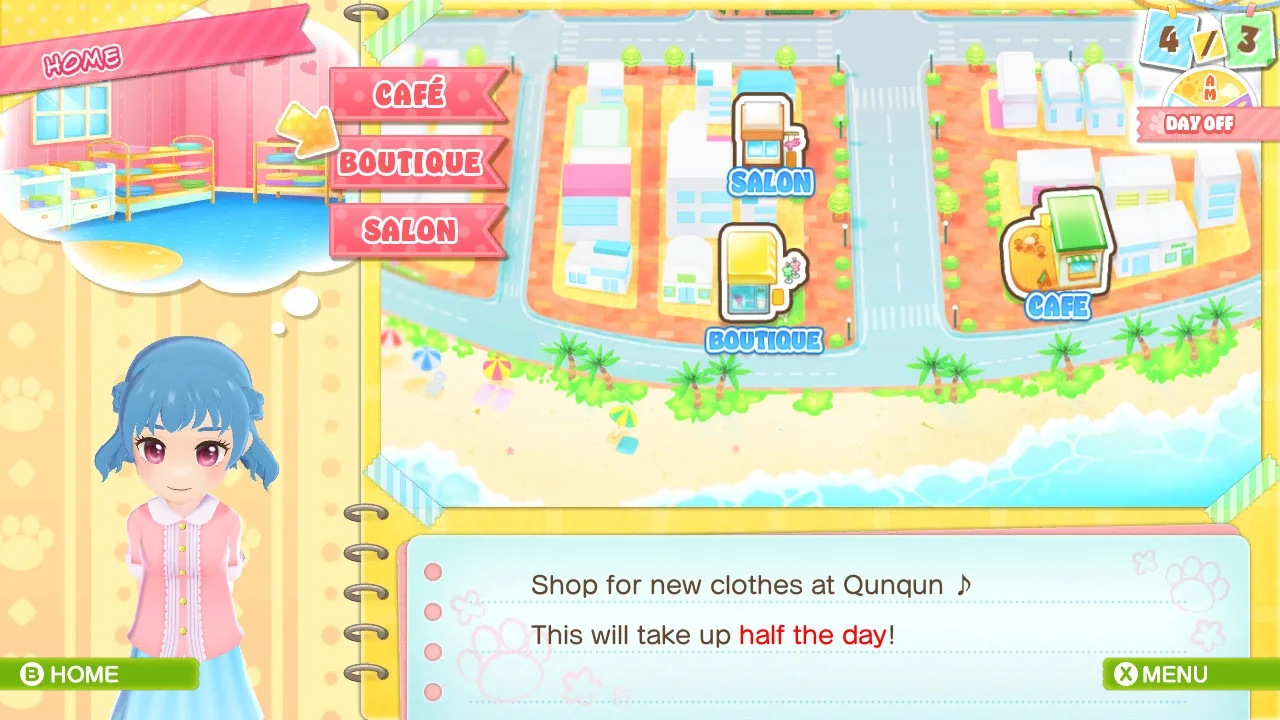
During the first few chapters of Pups & Purrs: Animal Hospital, there are just three locations you can visit if you choose to go out on your day off: Taste Tea café, Qunqun boutique, and Angel Crown salon. Taste Tea café serves seasonal food and drinks that boost your character stats, Qunqun boutique sells a range of clothing for your fashion needs, and Angel Crown salon lets you change your hairstyle and hair color. You may pop by each of these three locations to check what they currently have for sale without moving the time forward, which is great since you can then spend your time elsewhere if there is nothing that catches your eye at a particular shop. But once you purchase something, half a day will pass. Three additional locations will unlock as the story progresses in Story Mode, and they work similarly to the first three locations, only that they take up an entire day and focus on boosting your character stats.
Six entertainment venues may seem plenty and sufficient to convey the importance of taking a good break but unfortunately, they are quite shallow in design and provide barely any fun that could balance out the immense effort spent during the workdays. First of all, the so-called important rest days are always gone in a flash, within the span of a few taps of the screen or buttons. There are no special mini-games, fanciful cutscenes, or random slice-of-life moments to savor. You walk into Taste Tea café, pick an item from their current menu, read two or three brief sentences about your food or drink, and half a day is gone. Second, the two mildly fun shops, Qunqun boutique and Angel Crown salon, become boring quickly over time. I actually loved shopping at Qunqun boutique at first, taking my time to try on different combinations of tops, bottoms, socks, and shoes. But when there are fewer new styles and only more color variations of the same items pushed out, I soon found shopping at the boutique no longer as interesting. In fact, the more money I earned from work, the less I spent buying new clothes. The same happened with Angel Crown salon, which eventually features just seven hairstyles and six hair colors to choose from. What’s more, three of these hairstyles and all of the hair colors are the same as those available during the initial character creation of a new game. Third, the majority of the entertainment venues focus on raising the protagonist’s character stats rather than on having fun. Sure, the character stats are “Motivated”, “Relaxed”, and “Happy”, so in a way, raising “Relaxed” and “Happy” stats help convey the idea of having fun. However, apart from an increased number for the individual character stats, there is hardly anything else cementing the idea that our protagonist is indeed relaxed or happy. Moreover, the reward given for improving the character stats is bonus work stamps. Although the work stamps are cashed out to be spent on rest days, there is this weird connotation that the protagonist is having fun not for the sake of fun itself, but for getting more work stamps. Even on my rest days, I’m still technically grinding for work, for money! It may be enjoyable to observe my wealth accumulating, but I’d rather be rewarded with, say, an extra ticket I can use for inviting a colleague out somewhere on our next day off instead.

While the rest days have not exactly supplemented Pups & Purrs: Animal Hospital’s attempt at relaying the importance of a good work-life balance, I appreciate the range of activities included. There is even a location where you do not have to spend a dime to get your character stats boosted — certainly, not all fun activities must bore a hole through your wallet. Another thing I like is the clean and sleek user interface designs, especially for Qunqun boutique. Their huge wardrobe of clothes is not only categorized neatly by clothing types, but any piece you have previously bought is clearly marked as well. You can freely try on any of the available clothes and conveniently add all the unowned pieces in your current ensemble to the checkout screen with a single button press. Shopping at any of the shops is hassle-free and straightforward, though I wished the tutorial could have explained the icons used to indicate character stats boosts. It took me a while to decode that some icons represent a larger boost than the others.
Friendly Workplace and Supportive Colleagues
Pups & Purrs: Animal Hospital features a wonderfully supportive workplace that is thoroughly forgiving of any mistakes you make. You could fail to diagnose or treat your patient at all and still be thanked for your hard work even when your work summary reports have “POOR” written all over. You may express doubts about your work performance and chosen career path but your colleagues will be there to cheer you on. Your colleagues celebrate your achievements too, even if they repeat the same words every time. Here, it is a welcoming and comfortable setting where failures are not punished and successes are commended.
Such hospitality is made possible by the presence of five encouraging colleagues: Sakura Shirayuki (voiced by Sara Sakurai) the Director, Yuma Arai (voiced by Kenta Nishigaki), and Naoto Kagura (voiced by Naoki Takahashi) the veterinarians, as well as Kaname Saionji (voiced by Takuma Inoue) and Tsumugi Onodera (voiced by Mai Kanno) the paraveterinary workers. Their distinct personalities are paired with thoughtfully color-coded character designs, which is a simple but effective way to highlight each character’s individualism and make them visually memorable at the same time. For instance, Yuma is cool like the blue ocean, and Naoto is bursting with energy like the fiery sun. The respective voice artists bring out the characters’ personalities nicely, and it is a joy to hear most scenes in the main story being brought to life with the voiced dialogue.

Much to my pleasant surprise, the five colleagues are not just part of the main story but they star as the main characters in their own side stories too. While these side stories consist of scenes markedly shorter than those in the main story, they are unique to each colleague and allow you to learn more about everyone, such as the things they personally struggle with or their passions. Just like how you progress the main story by leveling up at your job, you progress the side stories by increasing your colleagues’ Trust in you. Easily found under the pause menu, the Trust gauge is displayed in the form of hearts. As you continue to chat with your colleagues during your free time, have lunch with them at lunchtime, or work with them in the examination rooms, you will slowly gain their Trust. There are a total of five hearts to fill up for everybody and with every gray heart filled with a color, a special short scene with them will unlock. Because the scenes are all slice-of-life in nature, they usually take place at the animal hospital. Only the fifth heart’s scenes tend to happen outside of work on a rest day, and I actually hoped Pups & Purrs: Animal Hospital would have given us more of this type of scene. After all, it is terribly lonely and boring to have to go out alone all the time on all of my rest days.
For the side stories, some are more intriguing than others. I like Tsumugi’s side story the most as there is excellent character development for her. Yuma’s side story is another favorite of mine as it contains dialogue choices that always had me cackling. And if this vet sim was a romance game, I’d have married Kaname for one of his scenes involved a totally romantic proposal-like setting where he just looked super dashing in his everyday outfit.
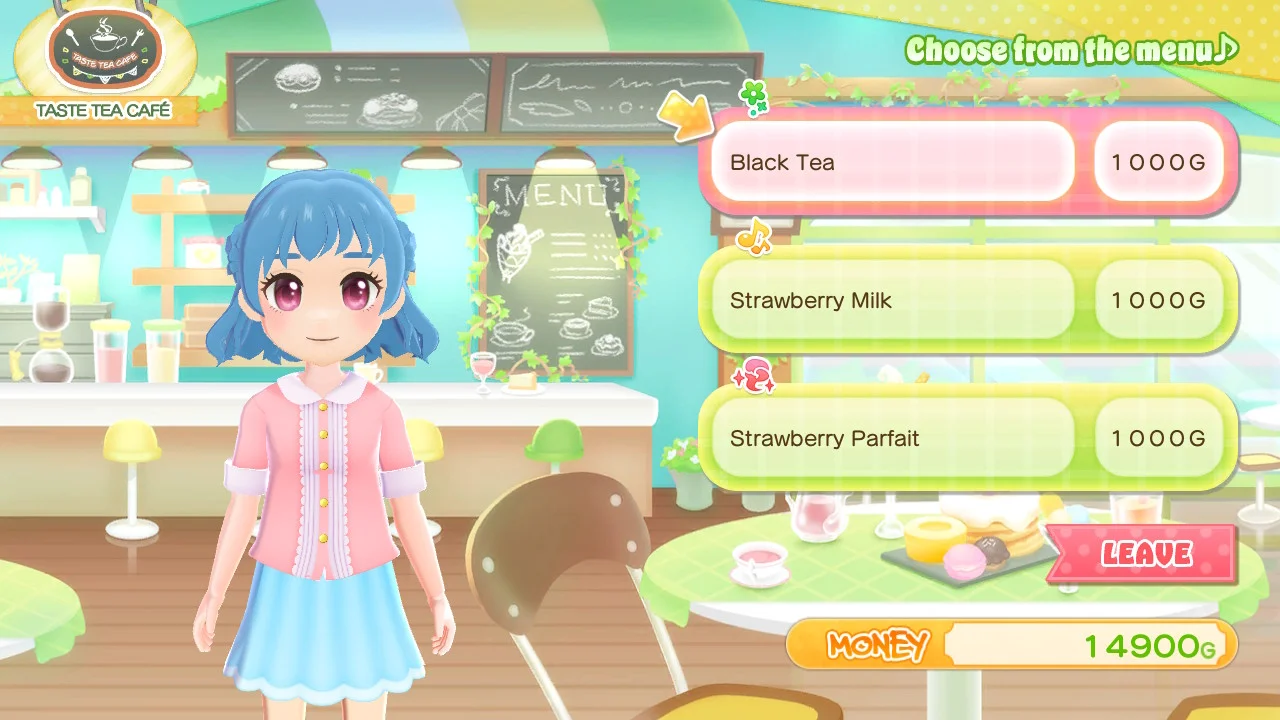
On the whole, I really like how playful the characters’ dialogues can be in Pups & Purrs: Animal Hospital. There are plenty of fun moments when various colleagues interact with one another, and everyone seems to really love to tease Yuma for some reason. Still, the best part about the characters’ dialogues is the amount of personality that oozes through them. For this reason, I especially love the lines for each colleague found under the Settings screen. It is amazing how their single-line reactions to the player tweaking the text speed or BGM, sound effects, and voice volumes reveal a lot about their personalities. The Director gives sound advice, Yuma comes across as serious, Naoto looks like he wants to join in the fun, Kaname is supportive and approving, and Tsumugi may be a little too excited to help.
Topping off well-written dialogue lines are hilarious dialogue choices that never fail to bring me smiles. Generally, there will be one dialogue choice that is professional and unmistakably the appropriate response, and another choice that is a joke option. Sometimes the nonsense choices make me second-guess if I were actually playing the same game where the pet treatments had been a no-nonsense process. Sadly, the dialogue choice’s funniness rarely extends past the choice point and some of the supposed joke choices can be quite rude. The non-playable characters will respond differently based on your dialogue choices but they would get over their gripes with any of your less-than-professional behaviors within the next sentence or two. If this vet sim intends to teach some lessons regarding common courtesy at the workplace, then the consequences of some impolite choices have been too subtle.

Verdict
Featuring a vibrant animal hospital where the staff are full of zest and trained to tackle a myriad of ailments, Pups & Purrs: Animal Hospital is a casual vet sim that is not just educational for younger players but entertaining for everyone. Most of the medical information presented is nothing new to me, yet that did not stop me from having plenty of fun, laughing, and smiling a lot throughout my 25 hours with the game. There is also something relaxing about playing mini-game after mini-game in an environment filled with bright pastel colors, pleasing chibi 3D character models, festive music, and realistic sound effects. And although things easily feel repetitive as the short main and side stories begin to wrap up, the healing effect I felt upon seeing the healed pets’ smiling faces hardly gets stale. Thus, no matter your age, if you love cute things, are interested in veterinary work, and enjoy playing casual mini-games, then Pups & Purrs: Animal Hospital could be a nice fit for you.
PUPS & PURRS: ANIMAL HOSPITAL IS RECOMMENDED

If you would like to read about Simulation games, you might be interested to read this review of Cat Cafe Manager
Many thanks go to Numskull Games for a Nintendo Switch review code for this title. Numskull Games published this title in the UK.
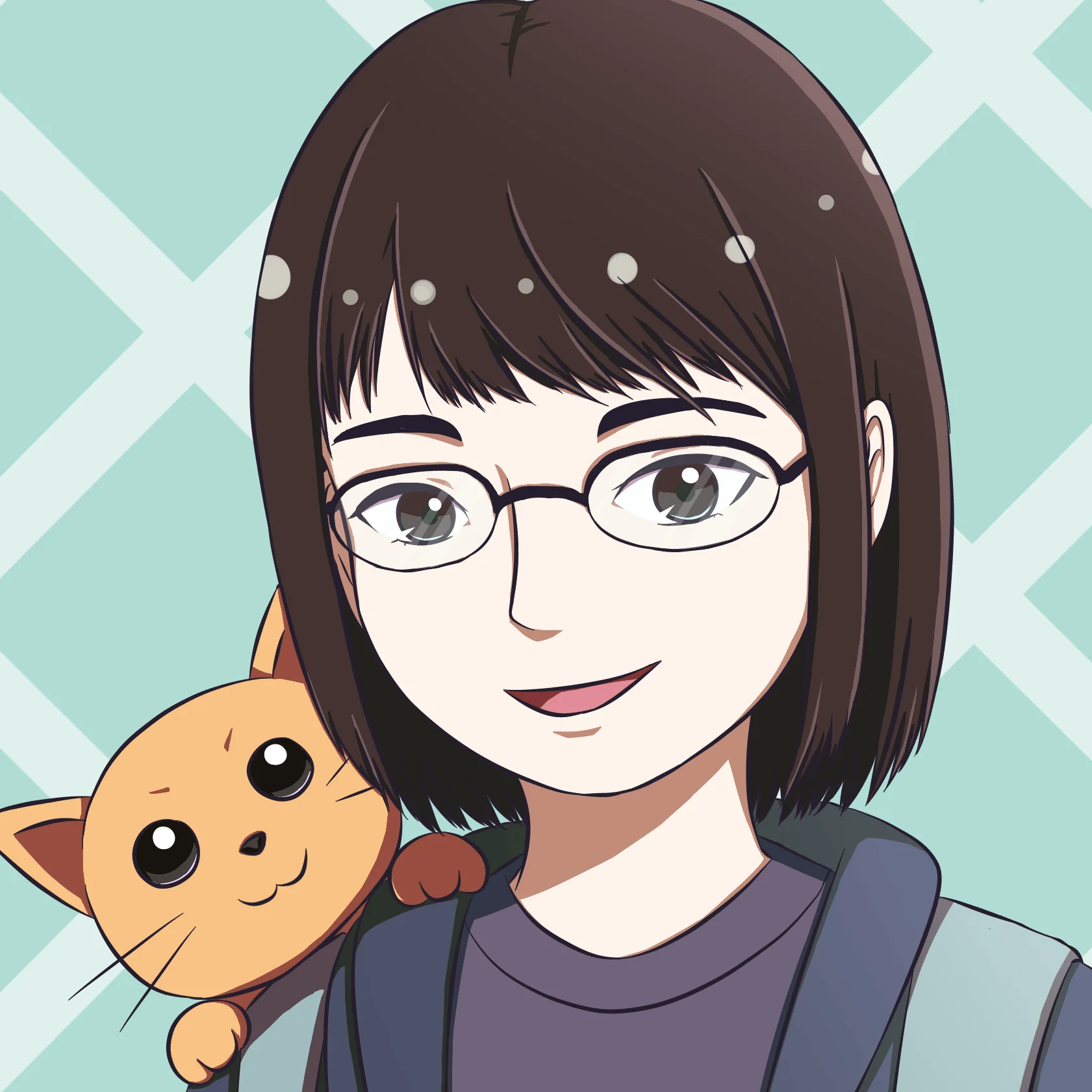
A person with many hobbies (and even more WIPs), KuroKairin plays, playtests, and reviews PC games. She loves games with good stories that bring her on an emotional and thought-provoking journey. Her favourite genres include otome visual novel, point and click, puzzle, and RPG. Follow her @KuroKairin.

